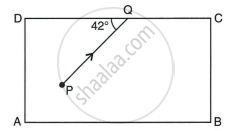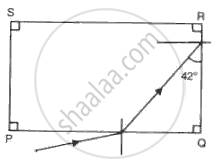Advertisements
Advertisements
प्रश्न
Choose the correct option.
Consider the following phenomena/ applications: P) Mirage, Q) rainbow, R) Optical fibre and S) glittering of a diamond. Total internal reflection is involved in
विकल्प
Only R and S
Only R
Only P, R and S
all the four
उत्तर
Only R and S
APPEARS IN
संबंधित प्रश्न
What do you understand by the deviation produced by a prism? Why is it caused?
Write the necessary conditions for the phenomenon of total internal reflection to
occur ?
Write the relation between the refractive index and critical angle for a given pair of optical media?
The diagram below shows a light source P embedded in a rectangular glass block ABCD of critical angle 42°. Complete the path of the ray PQ till it emerges out of the block. [Write necessary angles].

Define critical angle for a given medium.
Plot a graph between
Sine of angle of incidence versus sine of angle of refraction,
(a) A ray of monochromatic light enters glass PQRS as shown in the fig. Complete the path of ray till it emerges from the glass. (Critical angle of glass is 420).

(b) Draw diagram of a prism periscope.
(c) What are the advantages of total internal reflecting prism over plane mirror?
Name the principle on the basis of which optical fibres work.
How does a ray of light bend when it travels from rarer to denser medium
How does a ray of light bend when it travels from when it is normal to the interface of the two media.
State two advantages of using a right-angle prism as a reflector, rather than a plane mirror.
A ray of light incident at an angle of incidence ‘i’ passes through an equilateral glass prism such that the refracted ray inside the prism is parallel to its base and emerges from the prism at an angle of emergence ‘e’.
How is the angle of emergence ‘e’ related to the angle of incidence ‘i’?
A ray of light incident at an angle of incidence ‘i’ passes through an equilateral glass prism such that the refracted ray inside the prism is parallel to its base and emerges from the prism at an angle of emergence ‘e’.
What can you say about the value of the angle of deviation in such a situation?
Name the factors affecting the critical angle for the pair of media.
A spherical marble, of refractive index 1.5 and curvature 1.5 cm, contains a tiny air bubble at its centre. Where will it appear when seen from outside?
Which of the following is not involved in formation of a rainbow?
Answer the following question.
Describe the construction and working of an optical fibre.
Answer the following question.
Why is prism binoculars preferred over traditional binoculars? Describe its working in brief.
For a ray of light, the critical angle is minimum when it travels from ______.
Which of the following statements about total internal reflection is true?
The critical angle is defined as the angle of incidence at which the total internal reflection starts to occur.
A ray of light passes from vacuum into a medium of refractive index µ, the angle of incidence is found to be twice the angle of refraction. Then the angle of incidence is ______.
The angle made by incident ray of light with normal of the reflecting surface is called ______.
